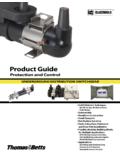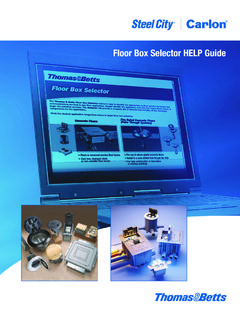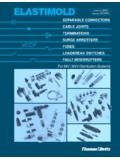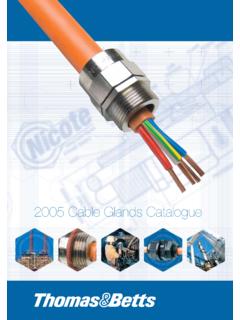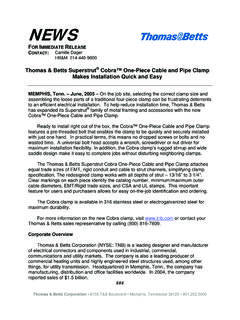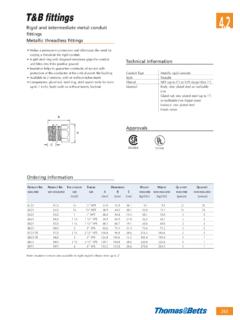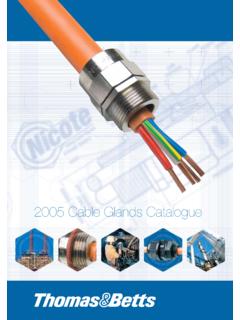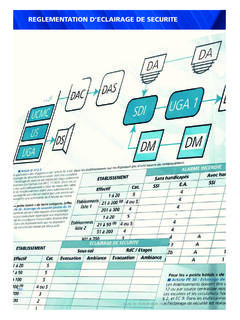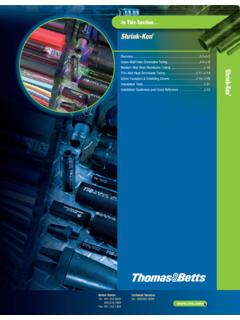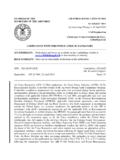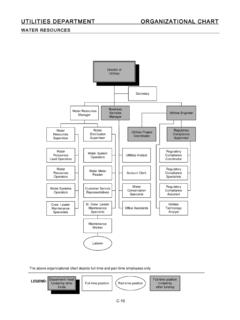Transcription of Fault Indicator Prod Guide - TNB.COM
1 Product GuideProtection and ControlVOLTAGE AND Fault INDICATORS Advanced AccQTrip Design Improves Accuracy, Performance and Reliability 5kV thru 35kV Rated for Underground and Overhead System Applications Easily Installed Test Point or Cable Clamp Mounting Styles Compact, Sealed, Corrosion Resistant Construction With Provision for Hotstick Installation and Operation Accurate Voltage and Phase Indicators Fault Indicators Include Choice of: Voltage or Time Reset Mechanical Flag or Flashing LED Display Units are Self Powered and Feature Automatic Trip and Reset Functions Exceeds ANSI/IEEE 495-1986 VOLTAGE AND Fault INDICATORSFEATUREAccQTrip Off The Trip Logic CircuitryAccQClamp Self AdjustingMounting ProvisionVoltage and/or TimeReset Fault IndicatorsHigh/Low TripSetting SelectionInrush Restraint CircuitryInternal AdjacentPhase Shielding1 mSec. Trip Response TimeUniversal StyleFault IndicatorsQuality ManufacturingProcessesBENEFIT/DESCRIPTIO NP revents false tripping due to transient current surges or system overloading.
2 No need for customer to specify cable when ordering cable mount FCI s. The AccQClamp maintains 10% trip accuracy over the entire clamping range (.4 ), and is composed of stable polycarbonate, stainless steel reinforced false resetting and false tripping associated with current (reset) dependent FCI s. Ideal for use on lightly loaded circuits where sufficient current may not be available to reliably energize a current reset type Fault Indicator . Automatic reset upon restoration of system voltage and/or time reset after 4 FCI s with current limiting fuses. No minimum load current requirements and no load surveys FCI s with circuit breaker or auto reclosure operation, avoiding mis-indication due to inrush electro-magnetic interference from adjacent phase FCI s with current limiting fuses, and other protective part numbers and inventory, simplifying the application and ordering using state-of-the-art surface mount technology, and premium quality electronic components, for the highest degree of performance and reliability.
3 All Fault indicators meet or exceed ANSI/IEEE Standard Indicators reduce outage duration by quickly pinpointing the location of the Fault . As shown in the circuit diagram, the Fault is located between the last tripped Indicator and the first untripped Indicator . Once identified, this section is switched to become the new open point, allowing full service restoration to the rest of the customers during FUSEAT RISER POLECABLEFAULTOPENPOINTFAULTED CIRCUITINDICATOR SHOWINGFAULTED CIRCUIT DISPLAYUNFAULTED CIRCUITINDICATOR SHOWINGNORMAL CIRCUIT DISPLAYUNDERGROUND LOOP CIRCUIT WITH ELBOW CONNECTED TRANSFORMERS T1 THRU T7T1T2T3T4T5T6T7 Protection and Control ProductsNowadays electric power underground distribution systems demand high performance in the form of improved reliability, improved power quality, reduced operational and maintenance costs, and flexibility of operation. These can be accomplished by sectionalizing feeders, installing equipment with minimal maintenance/installation costs, installing protection and/or automatic source transfer equipment, and providing ways to monitor the system and quickly locate a Fault .
4 Thomas & Betts Elastimold Voltage and Fault Indicators aid in the location and isolation of the faulted cable or equipment in overhead and underground distribution systems through 35kV. This product Guide details the different types of faulted circuit indicators, voltage indicators, and phase indicators. With a complete line of elbow test point mount and cable mount indicators, you will find the best product to meet your system s performance needs. 2 AccQTrip LOGIC OPERATIONF aulted Circuit Operationt1 Fault Indicator is connected to the system and powers up. At 5kV, this takes 3 min. in the case of the test point mounted unit, and 6 min. in the case of the overhead type unit. At higher voltages the power up time is Fault current is detected. Fault Indicator is Armed after 1ms. Fault Indicator display shows Breaker/recloser trips open and voltage Voltage is lost.
5 A 30 second time window allows for the protective device to clear the Fault , and reclose. If the Fault persists the Fault Indicator shows Operationt1 Fault Indicator is connected to the system and powers up. At 5kV, this takes 3 min. in the case of the test point mounted unit, and 6 min. in the case of the overhead type unit. At higher voltages the power up time is Device downline from Fault Indicator switches creating an overload. Fault Indicator is Armed after 1ms. Fault Indicator display shows More than 100ms without voltage loss. Fault Indicator does not change After 30 sec. Fault Indicator goes back to initialized Restraint Operationt1 Fault Indicator is connected to the system and powers up. At 5kV, this takes 3 min. in the case of the test point mounted unit, and 6 min. in the case of the overhead type unit. At higher voltages the power up time is - t2 Upline recloser / breaker operation due to Fault on another phase.
6 After 100ms (t2) the Fault Indicator is disabled because there is no Fault current Recloser closes back. Voltage is back to normal. Unfaulted phases see Inrush. No change in Fault POINT MOUNTED Fault INDICATORSTPM SeriesTest PointTest Point Mounting ProvisionProvision for Hotstick Installation and RemovalFaulted Circuit DisplayStandard Featuresn AccQTrip Logic Circuitry Prevents false indications due to inrush currents, cold load pickup, and overloadingn High/Low Trip Setting Selection No minimum load current requirement, and no load surveys Inrush Restraint Avoids misindicationn Internal Magnetic Shielding Prevents adjacent phase effectsn Trip Response .001 Seconds Coordinates with current limiting fuses, as well as other protection devicesn Magnetically Latched Flag Indication Flag Indication will not change state due to shock or vibrationn Light Weight, Compact and SealedTest Point Mounted Fault Indicators provide a clear, visual means for locating faulted cables and equipment on underground distribution systems.
7 Indicators are self-powered and consist of a solid state current sensor connected to a faulted circuit display. Designs incorporate advanced circuit logic, monitoring system protection operation and preventing Indicator tripping unless an overcurrent condition is followed by a loss of system voltage. Trip and reset operations are automatic and the same Indicator may be used for 5KV thru 35KV applications. Units are designed to mount directly to 200 & 600 Amp elbows, splices and other cable accessory components equipped with IEEE 386 Standard capacitive test points. Indicators include a universal mounting provision allowing installation on test point products as manufactured by Elastimold and feature compact, shielded and sealed, corrosion resistant construction. The Indicator is enclosed in a rugged, impact resistant Lexan housing and includes an EPDM molded rubber, test point mounting boot.
8 A built-in pulling eye allows for easy hotstick installation and removal of the Indicator from the test OperationA faulted circuit produces an associated magnetic field which closes a reed switch in the Indicator resulting in a tripped display. Trip response occurs in .001 seconds allowing the Fault Indicator to properly coordinate with all types of circuit protection schemes including current limiting eliminate confusing false trips, indicators are equipped with inrush, overload and cold load pick up restraint circuitry as standard. Current sensors are constructed with internal shielding to prevent inadvertent tripping when located in close proximity to adjacent phases, such as junction mounted TPMVFM odel TPMVL4 TEST POINT MOUNTED Fault INDICATORSTPM SeriesSpecifications for TPM Voltage Reset, Flag Display: Model TPMVFN ominal Trip RatingsResponse TimeSensor Indication Time Delay 1 Maximum Surge LevelEffect of Adjacent PhaseInrush Restraint ResponseLoad Current RequirementsDisplay TypeMinimum Reset VoltageVoltage Reset Time Power SourceTemperature RangeHousing Material WeightLow, 400 Amp; High, 800 Sec.
9 Subsequent To Arming25kA 10 Cycles 60 HzInternal Shielding Prevents Adjacent Phase Effects100mS (Disable Delay)NoneMechanical Flag5KV (Beginning Initializing Sequence)3 Minutes @ 5 KVVolt Test Point Powered-40 C To +85 CMounting Boot--EPDM Conductive RubberHousing Body--UV StabilizedPolycarbonate Polymer258 GramsSpecifications for TPM Voltage Reset, LED Display: Model TPMVLN ominal Trip RatingsTrip Response TimeFault Clearing Time 1 Maximum Surge LevelEffect of Adjacent PhaseInrush Restraint ResponseLoad Current RequirementsPower Up RequirementDisplay TypeFlash RateLED Display Time Voltage Reset Time Power Source 3 Battery CapacityBattery Operating LifeBattery Storage LifeTemperature RangeHousing Material WeightLow, 400 Amp; High, 800 Sec. Subsequent To Arming25kA 10 Cycles 60 HzInternal Shielding Prevents Adjacent Phase Effects100mS (Disable Delay)None3 Minutes @ 5kVFlashing Super Bright LED30 Flashes per Minute4 Hour--Standard 3 Minutes @ volt Lithium Thyonil Chloride Ah1200 Flash Hours Minimum15-20 Years-40 C To +85 CMounting Boot--EPDM Conductive RubberHousing Body--UV StabilizedPolycarbonate Polymer258 GramsSpecifications for TPM Time Reset, LED Display: Model TPMTL 2 Nominal Trip RatingsTrip Response TimeMaximum Surge LevelEffect of Adjacent PhasePower Up RequirementDisplay TypeFlash RateReset TimePower Source 3 Battery CapacityBattery Operating LifeBattery Storage LifeTemperature RangeHousing Material WeightLow, 400 Amp.
10 High, 800 Amp1mS25ka 10 Cycles 60 HzInternal Shielding Prevents Adjacent Phase EffectsNoneFlashing Super Bright LED30 Flashes per Minute4 volt Lithium Thyonil Chloride Ah1200 Flash Hours Minimum15-20 Years-40 C To +85 CMounting Boot--EPDM Conductive RubberHousing Body--UV StabilizedPolycarbonate Polymer258 GramsDIMENSIONSF ootnotes1) Prevents false trips due to short time interruptions without loss of ) Inrush restraint is standard on voltage reset models. It is not available on time reset ) Cell powers LED and it is active only when LED is ON. Lithium Thyonil Chloride Cells provide accurate indication throughout the entire temperature CABLE MOUNTED Fault INDICATORSUCM SeriesStandard Featuresn AccQClamp Mounting Provision Universal one-size-fits-all design automatically adjustsn High/Low Trip Setting Selection No minimum load current requirement, and no load surveys Trip Response.
